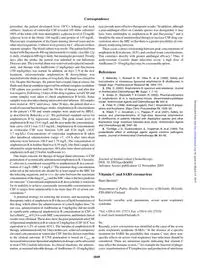
2003 Vitamin C and SARS coronavirus PDF
Preview 2003 Vitamin C and SARS coronavirus
Correspondence 1049 procedure, the patient developed fever (38°C), lethargy and neck stiffness. Analysis of ventricular CSF revealed 105 white cells/mm3 (90% of the white cells were neutrophils), a glucose level of 23 mg/dL (glucose level in the blood: 106 mg/dL) and protein of 119 mg/dL. Microscopic examination of the Gram staining showed yeast and no other microorganisms. Cultures were positive for C. albicans in three separate samples. The blood culture was sterile. The patient had been treated with fluconazole 400 mg intravenously (iv) daily, oxacillin 12 g iv daily, rifampicin 600 mg iv daily, but meningitis persisted. Twenty days after the stroke, the patient was admitted to our Infectious Diseases unit. The external shunt was removed and replaced immedi- ately, and therapy with AmBisome (3 mg/kg/day) and flucytosine (150 mg/kg/day) was started. In addition, on days 7–9 of the new treatment, intraventricular amphotericin B deoxycholate was injected into the shunt at a dose of 4 mg daily (the shunt was closed for 4 h). Despite this therapy, the patient had a torpid clinical course; his fluids and clinical condition improved but without complete resolution. CSF culture was positive until the 7th day of therapy and after this was negative. Following 23 days of this drug regimen, serial CSF and serum samples were taken to check amphotericin B levels. Some samples were also taken during intraventricular infusion. All samples were stored at –80°C until assay. After 30 days, the patient died as a result of a second haemorrhagic stroke. Amphotericin B concentrations in the patient’s CSF and serum samples were analysed by HPLC, as described by Bekersky et al.1 We performed standard curves for amphotericin B by regression analysis. The peak serum level of amphotericin B was 15.61 mg/L and the area under the concentration– time curve (AUC) was 115.5 mg·h/L. Amphotericin B concentrations in ventricular CSF were between 0.09 and 0.24 mg/L (AUC 3.7 mg·h/L). Concentrations of ventricular amphotericin B taken after intrathecal administration (range +7, +24 h after intra-shunt infusion) were between 100.5 and 1.75 mg/L. The concentration of amphotericin B in lumbar fluid was 0.59 mg/L (the fluid sample was obtained by single lumbar puncture, 48 h after intra-shunt infusion of amphotericin B and 22 h after AmBisome iv). One major concern, for therapy of fungal shunt infections, is CSF penetration of systemically administered amphotericin B. Currently, C. albicans is considered susceptible to amphotericin B at a concen- tration of 1 mg/L (MIC < 1 mg/L).2 The minimal drug concentration achieved at the infection site should be at least equal to the MIC for the infecting organism, and in vivo, the ratio between the maximum concentration of the drug (Cmax) and the MIC value is the best predictor for outcome.3 Conventional amphotericin B deoxycholate is notorious for its inability to achieve consistently measurable concentrations in CSF; it ranges from undetectable to no more than 4% of serum con- centrations.4 A potential strategy for reducing the toxicity and increasing the therapeutic index of amphotericin B is the use of lipid formulations of this drug, which allow the administration of a much higher dose.5 In our case, administration of AmBisome at 3 mg/kg/day did not result in significantly enhanced amphotericin B concentration in CSF; in fact a fluid Cmax of 0.24 is a sub-MIC concentration, and limited clinical results were obtained. These data show the poor penetration into CSF of liposomal amphotericin B at a dose of 3 mg/kg/day (CSF AUC was equivalent to 3.2% of serum AUC). The intrathecal amphotericin B therapy, administered only for 3 days in this case, achieved a temporary elevated concentration in ventricular CSF, but this did not contribute to the clinical outcome. If CNS penetration is based on Cmax, an increased intravenous liposomal amphotericin dosage can be advocated to treat CNS Candida infections. In clinical situations, the adminis- tration, at maximal tolerable dosage, of AmBisome (5–10 mg/kg/day) may provide more effective therapeutic results.5 In addition, although a post-antifungal effect on Candida species was disregarded, it may have been attributable to amphotericin B and flucytosine,6 and it should be the aim of antimicrobial therapy to increase CSF drug con- centration above the MIC so that there is a greater possibility of com- pletely eradicating infection. There exists a direct relationship between peak concentrations of amphotericin B in plasma, AUCs and cerebral tissue concentrations. This correlates directly with greater antifungal efficacy.5 Thus, if azole-resistant Candida shunt infections occur, a high dose of AmBisome (5–10 mg/kg/day) may be a reasonable option. References 1. Bekersky, I., Boswell G. W., Hiles R. et al. (1999). Safety and toxicokinetics of intravenous liposomal amphotericin B (AmBisome) in beagle dogs. Pharmaceutical Research 16, 1694–701. 2. Ellis, D. (2002). Amphotericin B: spectrum and resistance. Journal of Antimicrobial Chemotherapy 49, Suppl. 1, 7–10. 3. Andes, D., Stamsted, T. & Conklin, R. (2000). Pharmacodynamics of amphotericin B in a neutropenic-mouse disseminated-candidiasis model. Antimicrobial Agents and Chemotherapy 45, 922–6. 4. Patel, R. (1998). Antifungal agents. Part I. Amphotericin B prepar- ations and flucytosine. Mayo Clinic Procceedings 73, 1205–25. 5. Walsh, T. J., Goodman, J. L., Pappas, P. et al. (2001). Safety, tol- erance and pharmacokinetics of high-dose liposomal amphotericin B (AmBisome) in patients infected with Aspergillus species and other filamentous fungi: maximum tolerated dose study. Antimicrobial Agents and Chemotherapy 45, 3487–96. 6. Turnidge, J. D., Gudmundsson, S., Vogelman, B. et al. (1994). The postantibiotic effect of antifungal agents against common pathogenic yeasts. Journal of Antimicrobial Chemotherapy 34, 83–92. Journal of Antimicrobial Chemotherapy DOI: 10.1093/jac/dkh002 Advance Access publication 12 November 2003 Vitamin C and SARS coronavirus Harri Hemilä* Department of Public Health, University of Helsinki, Helsinki, FIN-00014 Finland Keywords: ascorbic acid, pneumonia, severe acute respiratory syndrome *Tel: +359-0-191-27573; Fax: +358-0-191-27570; E-mail:
